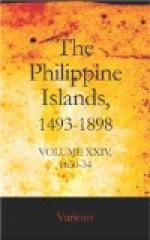Since then those fathers have continued to establish convents here. For as they were the last, and the islands are in the conditions under which Miguel Lopez de Legazpi left them, there was not before any place where they could settle. However, outside Manila, they possess a small house called Sampaloc, because it has many tamarind trees. There they minister to a few Tagals, and one religious lives there generally. [12] It has a stone church and house. They have a garden with a stone house and its chapel (where one religious lives), near the walls of Manila, in the suburbs. Opposite the island of Mariveles, in the same district of Manila, they have a Tagal mission. It is but small, and, with its visitas, does not amount to four hundred Indians. But farther along the coast, they have two Zambal missions of settled Indians, which are situated nearer here than Ilocos. One is called Masinloc and the other Bolinao. [13] Each one must have more than five hundred Indians. They have also extended from here to other islands. They must have three convents in the islands of Cuyo and Calamianes, more than sixty leguas from Manila. Those islands are full of people, so that, if they would come down from the mountains, many missions might be established; for in that region the islands are innumerable. There is the large island of Paragua, and thence succeed islands and islets even to Burney, the largest island known in all this archipelago. But there is little hope of entering it, for the king and all the coast Indians are Mahometans. But those living in the upland and mountains are even pagans. By the above, the ease with which this damnable poison has extended will be apparent. Had God’s mercy been retarded a trifle longer in hastening the steps of the Spaniards, the latter would have found no place to settle; for as I have remarked, long experience shows that the Mahometan will not receive the Christian law which is so contrary to his hellish customs. The religious suffered many things in those islands as they were exposed to a thousand temporal dangers, and to enemies, with whom the whole region swarms. Those missions had seculars; and although they did their best, yet at present that region has another luster, for it appears that the religious, being more in number, are more suitable for this work.
Bishop Don Fray Pedro de Arce gave the fathers another mission in the island of Negros, opposite the island of Panay. I think it their best mission, as it is located nearer us. It has two religious, who do very good work. The bishop gave them also many missions in Caraga, where they will be able to spread. Later, we shall conclude this subject with what the fathers have built in Cavite, the port of Manila, in honor of San Nicolas—namely, a house and church, which is the best there.
[About the time that the Recollects sail Father Master Solier is preparing also to go to the Philippines. He has been given “equal power with him whom the province sent as procurator, in case of the latter’s death.” The procurator dies at sea, whereupon Father Solier assumes his office. He sails with twenty-six Augustinian religious, eight of whom remain in New Spain—where they suffer many things, for the government of affairs there falls into the hands of the creole fathers.]




